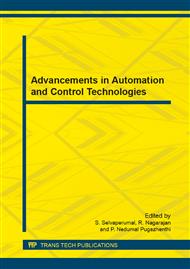[1]
Johan Akesson, Ola Sl¨atteke, Modeling, Calibration and Control of a Paper Machine Dryer Section, Modelica 2006, September 4–5.
Google Scholar
[2]
Xuetingwang, shengshuocao, modelling paper drying with ComsolMultiphysicsModeling Tool" Bachelor, s Thesis, (2013).
Google Scholar
[3]
Magnus Karlsson, Ola Slätteke, Tore Hägglund, and StigStenström, Feedforward Control in the Paper Machine Drying Section, Proceedings of the 2006 American Control Conference, June 14-16, (2006).
DOI: 10.1109/acc.2006.1656506
Google Scholar
[4]
Ajit K Ghosh, fundamentals of paper drying-theory and application from industrial perspective, Evaporation, Condensation and Heat Transfer.
DOI: 10.5772/21594
Google Scholar
[5]
Yeong-Koo Yeo†, Ki-Seok Hwang, Sung Chul Yi and Hong Kang, Modeling of the Drying Process in Paper Plants, Korean J. Chem. Eng., pp-761-766, (2004).
DOI: 10.1007/bf02705517
Google Scholar
[6]
Chang Hoe Heo, Hyunjun Cho, and Yeong-Koo Yeo, Dynamic modeling of paper drying processes, Korean J. Chem. Eng., pp- 1651-1657, (2011).
DOI: 10.1007/s11814-011-0046-0
Google Scholar
[7]
Anita Zvolinschi, EivindJohannessen, Signe Kjelstrup, The second-lawoptimal operation of a paper drying machine, Chemical Engineering Science, pp-3653 – 3662, (2006).
DOI: 10.1016/j.ces.2005.12.030
Google Scholar
[8]
T. Lu,S.Q. Shen, Numerical and experimental investigation of paper drying: Heat and mass transfer with phase change in porous media, Applied Thermal Engineering, pp-1248–1258, (2007).
DOI: 10.1016/j.applthermaleng.2006.11.005
Google Scholar
[9]
Timothy F. Murphy, Stephen Yurkovich, and Shih-Chin Chen, Intelligent control for paper machine moisture control, proceeding of the 1996 IEE international conference on control application Dearborn, September, pp: 15-18, (1996).
DOI: 10.1109/cca.1996.558974
Google Scholar
[10]
ErandaHarinath, George K. I. Mann, Design of tuning of standard additive model based fuzzy PID controllers for multivariable process syestems, IEEE transactions on systems, man , and cybernetics, vol. 38, No. 3, june (2008).
DOI: 10.1109/tsmcb.2008.919232
Google Scholar
[11]
Keyu Li, PID Tuning for Optimal Closed-loop performance with specified gain and phase margins, IEEE transactions on control systems technology, vol. 21, No. 3, may2013.
DOI: 10.1109/tcst.2012.2198479
Google Scholar
[12]
K. S. Tang, Kim Fung Man, Guanrong Chen, Fellow, An Optimal Fuzzy PID Controller, IEEE TRANSACTIONS ON INDUSTRIAL ELECTRONICS, vol. 48, No. 4, August 20.
DOI: 10.1109/41.937407
Google Scholar
[13]
Wen Tan, unified tuning of PID load frequency controller for power systems via IMC, IEEE TRANSACTIONS ON POWER SYSTEMS, Vol. 25, No. 1, Feb (2010).
DOI: 10.1109/tpwrs.2009.2036463
Google Scholar
[14]
Kiyong Kim, Member, PraneshRao, and Jeffrey A. Burnworth, Self-Tuning of the PID Controller for a digital Excitation Control system, IEEE TRANSACTIONS ON INDUSTRY APPLICATIONS, Vol. 46, No. 4, JULY/August2010.
DOI: 10.1109/tia.2010.2049631
Google Scholar
[15]
Vicente Milanés, Jorge Villagrá, Jorge Godoy, and Carlos González, Comparing Fuzzy and Intelligent PI Controllers in Stop-and-Go Manoeuvres, IEEE TRANSACTIONS ON CONTROL SYSTEMS TECHNOLOGY, Vol. 20, No. 3, May (2012).
DOI: 10.1109/tcst.2011.2135859
Google Scholar
[16]
Zaojun Fang, De Xu and Min Tan, A Vision-Based Self-tunning fuzzy controller for Fillet Weld Seam Tracking, IEEE/ASME TRANSACTIONS ON MECHATRONICS, Vol. 16, No. 3, June (2011).
DOI: 10.1109/tmech.2010.2045766
Google Scholar
[17]
Xinyu Du, Student Member, and Hao Ying, Derivation and Analysis of the Analytical Structures of the interval type-2 fuzzy-PI and PD controller, IEEE TRANSACTIONS ON FUZZY SYSTEMS, Vol. 18, No. 4, Augu.
DOI: 10.1109/tfuzz.2010.2049022
Google Scholar


